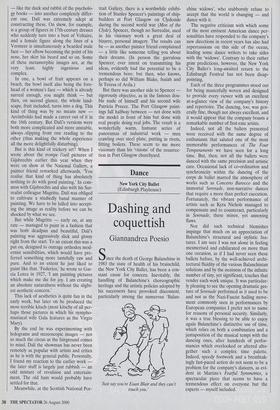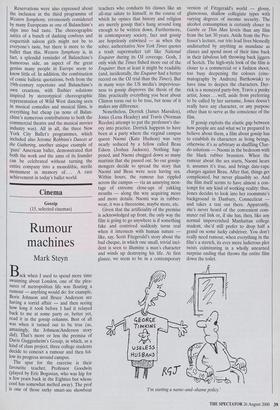Dance
New York City Ballet (Edinburgh Playhouse)
Dashing and coquettish
Giannandrea Poesio
Since the death of George Balanchine in 1983 the state of health of his brainchild, the New York City Ballet, has been a con- stant cause for concern. Inevitably, the handling of Balanchine's choreographic heritage and the artistic policies adopted by his successors have provoked discontent, particularly among the numerous `Balan- `Just say you're Euan Blair and they can't touch you.' chine widows', who stubbornly refuse to accept that the world is changing — and dance with it.
The negative criticism with which some of the most eminent American dance per- sonalities have responded to the company's new directions in recent years has also had repercussions on this side of the ocean, leading some dance writers to take sides with the 'widows'. Contrary to their rather grim predictions, however, the New York City Ballet's long-awaited return to the Edinburgh Festival has not been disap- pointing.
Each of the three programmes stood out for being masterfully woven and designed to provide every viewer with an excellent at-a-glance view of the company's history and repertoire. The dancing, too, was gen- erally fine, though not always excellent, and it would appear that the company boasts a remarkable number of first-rate artists.
Indeed, not all the ballets presented were received with the same degree of enthusiasm that saluted one of the most memorable performances of The Four Temperaments we have seen for a long time. But, then, not all the ballets were danced with the same precision and artistic care. Occasional lack of co-ordination and synchronicity within the dancing of the corps de ballet marred the atmosphere of works such as Concerto Barocco and the immortal Serenade, non-narrative dances that require a more than perfect execution. Fortunately, the vibrant performance of artists such as Kyra Nichols managed to compensate and to counteract, particularly in Serenade, these minor, yet annoying flaws.
Nor did such technical blemishes impinge that much on an appreciation of Balanchine's structural and stylistic fea- tures. I am sure I was not alone in feeling mesmerised and exhilarated on more than one occasion, as if I had never seen these ballets before, by the well-achieved archi- tectural fluidity of the various Balanchinian solutions and by the neatness of the infinite number of tiny, yet significant, touches that render each work unique. It was particular- ly pleasing to see the opening dramatic ges- ture of Serenade performed as it used to be and not as the Nazi-Fascist hailing move- ment commonly seen in performances by European companies I prefer not to name for reasons of personal security. Similarly, it was a true blessing to be able to enjoy again Balanchine's distinctive use of time, which relies on both a combination and a juxtaposition of the musical tempi with the dancing ones, after hundreds of perfor- mances which overlooked or altered alto- gether such a complex time palette. Indeed, speedy footwork and a breathtak- ingly fast-paced action do not seem to be a problem for the company's dancers, as evi- dent in Martins's Fearful Symmetries, a spectacular piece that seems to have a tremendous effect on everyone but the experts — myself included. Reservations were also expressed about the inclusion in the third programme of Western Symphony, erroneously considered by many Europeans as one of Balanchine's slips into bad taste. The choreographic antics of a bunch of dashing cowboys and coquettish saloon girls might not be to everyone's taste, but there is more to the ballet than this. Western Symphony is, in fact, a splendid reminder of Balanchine's humorous side, an aspect of the great genius many people in Europe seem to know little of. In addition, the combination of comic balletic quotations, both from the 19th-century repertoire and Baianchine's own creations, with flashier solutions inspired by stereotypical choreographic representation of Wild West dancing seen In musical comedies and musical films, is everything but cheap (as none of Balan- chine's numerous contributions to both the commercial theatre and the musical movies industry was). All in all, the three New York City Ballet's programmes, which included also Jerome Robbins's Dances at the Gathering, another unique example of `pure' American ballet, demonstrated that both the work and the aims of its founder can be celebrated without turning the entire company into a monolithic, sterile monument in memory of ... A rare achievement in today's ballet world.



























































 Previous page
Previous page